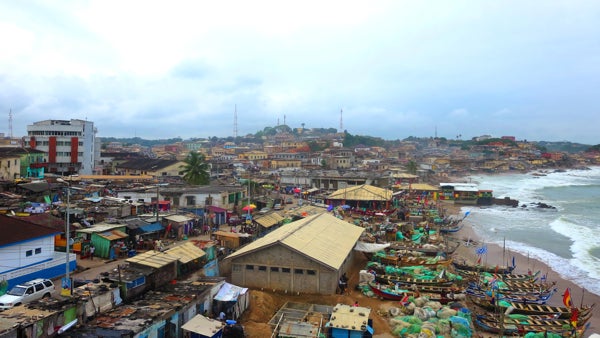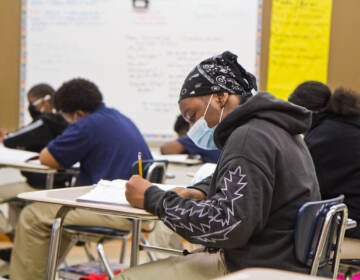One descended from slaves, one whose ancestors aided traders explore shared history in Ghana
Listen
Lehigh University's Ghana Study Abroad group in the summer of 2016 includes Professor James Peterson (fourth from left) and Professor Kwame Essien (center). This photo was taken at Cape Coast Slave Castle. (Miles Davis)
A new study-abroad program at Lehigh University in Bethlehem, Pennsylvania, takes students to Ghana, in part, to explore slave castles and other historic sites related to the trans-Atlantic slave trade.
The two Lehigh professors in charge both have family ties to colonial slavery — but from opposite sides.
James Peterson, the director of the Africana studies program at Lehigh and also of WHYY’s The Remix podcast, has been taking students to Ghana for three summers.
“It’s one thing to teach about slavery from a textbook in the classroom,” he said. “Another thing to watch powerful compelling films about the history of slavery, and it’s another thing entirely to actually stand in the structures where our ancestors suffered and died.”
His first visit to the “slave castles” in Ghana was profound, especially as the descendant of slaves.
 Professor James Peterson talks with Lehigh student Karen Valerio during a visit to Cape Coast Slave Castle in summer, 2016. (Miles Davis)
Professor James Peterson talks with Lehigh student Karen Valerio during a visit to Cape Coast Slave Castle in summer, 2016. (Miles Davis)
The slave castles were large commercial forts, built on what was then called the Gold Coast of West Africa by European traders. From the 17th to 19th century, it’s estimated 12 million men, women and children were held captive in the structures until they were shipped away to be sold in the New World.
“When I first experienced Elmina Castle … I can remember having a very emotional experience in that space,” Peterson said. “And really trying to come to terms with what I was feeling and thinking and why the actual physical structures and the narrative of the history of that space had such a compelling impact on me.”
It’s important to challenge students, he said. Even if it means confronting intense subject matter.
“There are no trigger warnings that can prepare you for how you’re going to feel when you’re standing in a slave dungeon,” he said. “There just aren’t any.”
 A window looking out one of the slave forts in Ghana during summer 2015. (Miles Davis)
A window looking out one of the slave forts in Ghana during summer 2015. (Miles Davis)
The opportunity to learn outside the classroom also allows students to see faculty in different ways, said Peterson, who teaches English at Lehigh.
Kwame Essien, assistant professor of history and Africana studies at Lehigh, was born and raised in Ghana, which has approximately 40 percent of the historic slave castles used during the trans-Atlantic slave trade.
His family is from Elmina, a coastal town in Ghana with a strong history of slavery.
“My family has this history with colonialism to colonial rule,” he said. “My great-great-great-grandfather on my mother’s side, his name was Chief Kweku Andoh. So Chief Kweku Andoh was the chief of Elmina from 1884 to 1898.”
Essien, the director of the Ghana study abroad program, says students are intrigued by his family’s history.
“I think they find it very interesting,” he said. “Especially when I show them documents to prove that this chief was actually connected somehow with — I don’t have any documented proof that he was a slave merchant or he was involved in slavery — but I have documents from the family house to show he sort of worked closely with the British to succeed in the colonial endeavors.”
 The area surrounding the Elmina Slave Castle photographed in the summer of 2015. (Miles Davis)
The area surrounding the Elmina Slave Castle photographed in the summer of 2015. (Miles Davis)
Some of Essien’s ancestors wanted to align with the British to fight a common enemy, but the price was enslaving other Africans.
“The main kingdom in Ghana, which is the Ashanti kingdom, was so powerful that it was controlling and beating up anybody else along the coast and within the country,” Essien said. “So Chief Andoh and other chiefs feel like the British were there to be allies, to be able to help them to defeat the common enemy.”
The Elmina slave castle is not far from Essien’s ancestral home.
“The castle is just about 12 blocks or 10 blocks from the family house,” he said. “So I take them there and explain to them. There is a picture of the chief there, so that also allows them to see the reality of slavery. It’s not just about going to the slave castles, but actually there were people who lived here who were connected somehow as leaders of the community to the story of slavery and the story of colonial rule.”
His family history generates many questions from students who are usually fairly curious.
“It opens up more room for more questions. I will answer as many as I can, but I think the students, in my opinion, are a little more open-minded,” Essien said. “But when it comes to adults, like faculty, I’ve seen different faculty taking it personally when I share this family history. They take it to another level or maybe some adults will look at it more of, ‘Oh, your ancestors sold us into slavery.’ They start a blame game. ‘You did this you did that.'”
 Chains and shackles are displayed at a slave castle. (Miles Davis)
Chains and shackles are displayed at a slave castle. (Miles Davis)
Essien says he sees his family history as a teachable moment.
“But the truth is I wasn’t around, you know,” he said. “Of course, this is something that I’m learning, and I’m not proud of it but it is history. So it needs to be shared so that perhaps the next generation will not repeat some of these mistakes. But we use all these opportunities for educational purposes.”
He says, ironically, some Americans have a better understanding of the slavery than those living in Ghana.
“The local people are not directly connected to these sites even though it’s right behind their backyard,” he said.
He tells his students, “Don’t expect the local person to be sharing the same tears that I shed or you may shed because they look at those sites differently because of the history with the place and because they’ve not experienced that as perhaps your ancestors did.”
 The Elmina Castle Door of No Return is the last place the slaves would see their homeland before boarding the slave ships. (Miles Davis)
The Elmina Castle Door of No Return is the last place the slaves would see their homeland before boarding the slave ships. (Miles Davis)
Essien says his emotions aren’t same as African-Americans on the topics of slavery and racism since they aren’t often discussed in Ghana.
“It is very difficult for me to express my emotions because my emotions are quite different from especially people of African descent who go back.”
He sometimes gets questions about why he wants to spend so much time talking about and researching the slave trade, especially from Ghanaian family members.
The program, now in its third year, is planning to expand to include trans-Atlantic slave trade sites in Cuba as well places in the U.S. involved in slavery.
This immersive study abroad experience is made possible through a gift from Lehigh Alum, Ron Ulrich, who provided support for four Lehigh undergraduates to travel to Ghana over each of the next four years. Additional funding support for Lehigh students to experience the history and culture of Ghana is provided by various donors, including Trevor Bond, Dale Strohl and John Franchini, as well as the Lee Iaccoca International Internship Program at Lehigh University.
This is part two in a series on Lehigh’s study abroad program. You can find the first part here.
WHYY is your source for fact-based, in-depth journalism and information. As a nonprofit organization, we rely on financial support from readers like you. Please give today.




